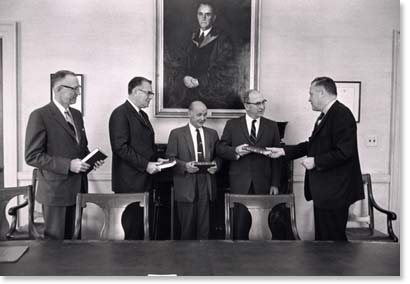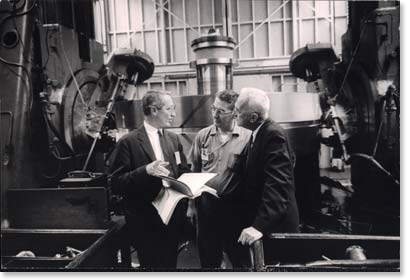
The “Hawthorne Effect”
What Mayo urged in broad outline has become part of the orthodoxy of modern management.Abraham Zaleznik, Professor of Leadership, Emeritus, Harvard Business School, 1984
 Jonathan L. Thiesmeyer (Western Electric), Donald W. Thomas (Western Electric), Fritz J. Roethlisberger, William J. Dickson (Western Electric), and Harvard Business School Dean George P. Baker at the completion of Counseling in an Organization, December 6, 1966
Jonathan L. Thiesmeyer (Western Electric), Donald W. Thomas (Western Electric), Fritz J. Roethlisberger, William J. Dickson (Western Electric), and Harvard Business School Dean George P. Baker at the completion of Counseling in an Organization, December 6, 1966HBS Archives Photograph Collection
In 1966, Roethlisberger and William Dickson published Counseling in an Organization, which revisited lessons gained from the experiments. Roethlisberger described “the Hawthorne effect” as the phenomenon in which subjects in behavioral studies change their performance in response to being observed. Many critics have reexamined the studies from methodological and ideological perspectives; others find the overarching questions and theories of the time have new relevance in light of the current focus on collaborative management. The experiments remain a telling case study of researchers and subsequent scholars who interpret the data through the lens of their own times and particular biases.12
 Paul R. Lawrence, ca. 1960
Paul R. Lawrence, ca. 1960HBS Archives Photograph Collection
Mayo and Roethlisberger helped define a new curriculum focus, one in alliance with Dean Donham’s desire to address social and industrial issues through field-based empirical research. Harvard’s role in the Hawthorne experiments gave rise to the modern application of social science to organization life and lay the foundation for the human relations movement and the field of organizational behavior (the study of organizations as social systems) pioneered by George Lombard, Paul Lawrence, and others.
“Instead of treating the workers as an appendage to ‘the machine’,” Jeffrey Sonnenfeld notes in his detailed analysis of the studies, the Hawthorne experiments brought to light ideas concerning motivational influences, job satisfaction, resistance to change, group norms, worker participation, and effective leadership.13 These were groundbreaking concepts in the 1930s. From the leadership point of view today, organizations that do not pay sufficient attention to ‘people’ and ‘cultural’ variables are consistently less successful than those that do. From the leadership point of view today, organizations that do not pay sufficient attention to people and the deep sentiments and relationships connecting them are consistently less successful than those that do. “The change which you and your associates are working to effect will not be mechanical but humane.”14
- 12
- See Richard Gillespie, Manufacturing Knowledge: A History of the Hawthorne Experiments. Cambridge: Cambridge University Press, 1991, and Jeffrey A. Sonnenfeld, "Shedding Light on the Hawthorne Studies," Journal of Occupational Behavior, Vol. 6, 1985. ←
- 13
- Jeffrey A. Sonnenfeld, "Shedding Light on the Hawthorne Studies," Journal of Occupational Behavior, Vol. 6, 1985, p. 125. ←
- 14
- Letter from Elton Mayo to George A. Pennock, October 28, 1929. Elton Mayo Papers, Box 7, Baker Library, Harvard Business School. ←
- Baker Library | Historical Collections | Site Credits | Digital Accessibility
- Contact Email: histcollref@hbs.edu